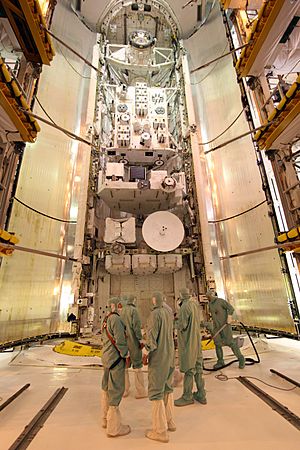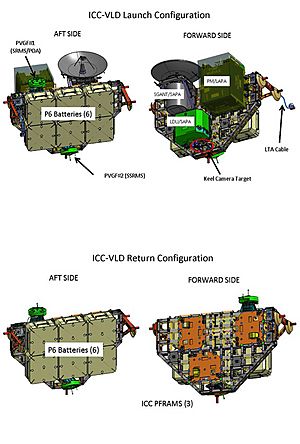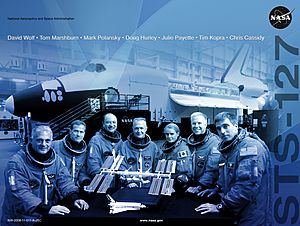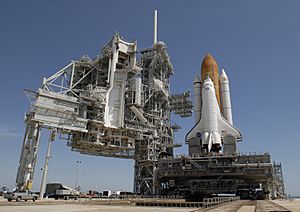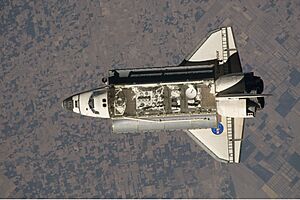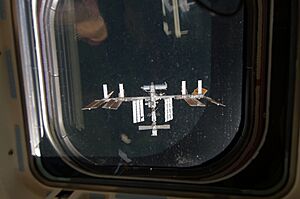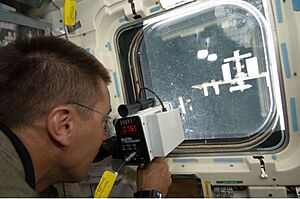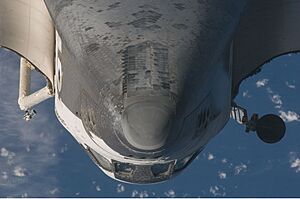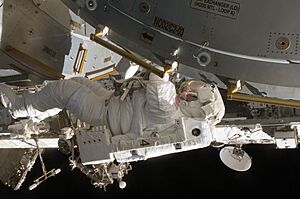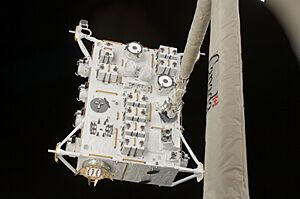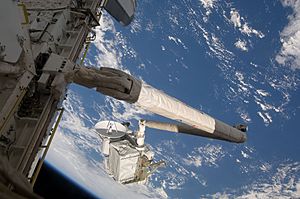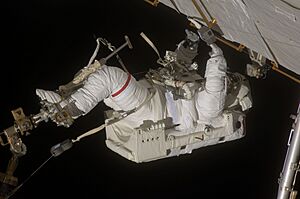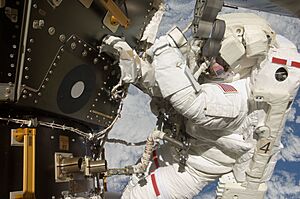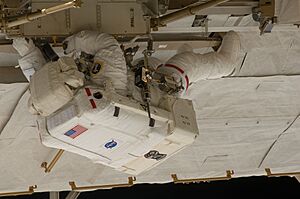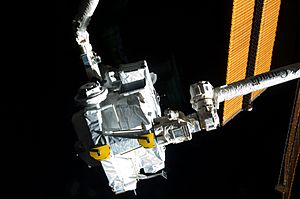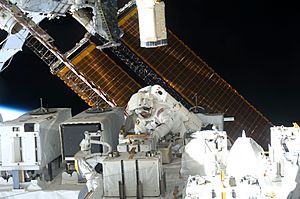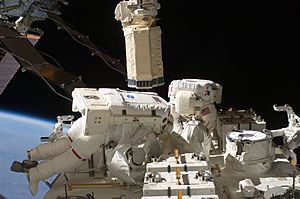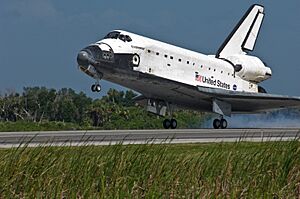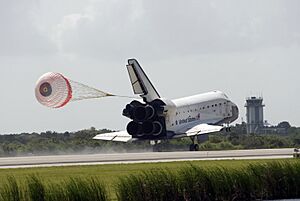STS-127 facts for kids
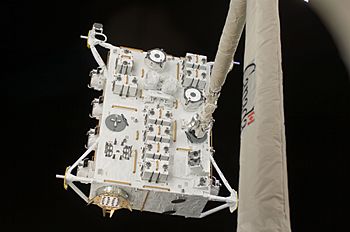
Canadarm2 grapples the exposed facility of Kibō, prior to its installation on the ISS
|
|
| Mission type | ISS assembly |
|---|---|
| Operator | NASA |
| Mission duration | 15 days, 16 hours, 44 minutes, 58 seconds |
| Distance travelled | 10,537,748 kilometres (6,547,853 mi) |
| Orbits completed | 248 |
| Spacecraft properties | |
| Spacecraft | Space Shuttle Endeavour |
| Crew | |
| Crew size | 7 |
| Members |
|
| Launching |
|
| Landing | |
| Start of mission | |
| Launch date | 15 July 2009, 22:03 UTC |
| Launch site | Kennedy LC-39A |
| End of mission | |
| Landing date | 31 July 2009, 14:48 UTC |
| Landing site | Kennedy SLF Runway 15 |
| Orbital parameters | |
| Reference system | Geocentric |
| Regime | Low Earth |
| Perigee | 344 kilometres (214 mi) |
| Apogee | 351 kilometres (218 mi) |
| Inclination | 51.6 degrees |
| Period | 91.48 minutes |
| Epoch | 18 July 2009 |
| Docking with ISS | |
| Docking port | PMA-2 (Harmony forward) |
| Docking date | 17 July 2009, 17:47 UTC |
| Undocking date | 28 July 2009, 17:26 UTC |
| Time docked | 10 days, 23 hours, 41 minutes |
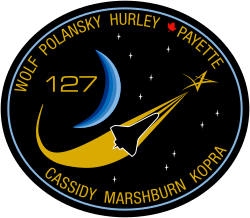 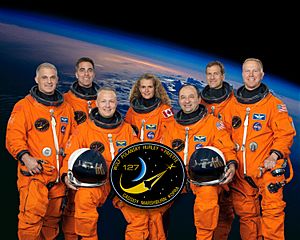 From left to right: Wolf, Cassidy, Hurley, Payette, Polansky, Marshburn, and Kopra |
|
STS-127 was a NASA Space Shuttle mission to the International Space Station (ISS). It was the twenty-third flight of the Space Shuttle Endeavour. The main goal of STS-127 was to deliver and install the last two parts of the Japanese Experiment Module, called Kibō. These parts were the Exposed Facility (JEM EF) and the Exposed Section of the Experiment Logistics Module (ELM-ES).
When Endeavour docked with the ISS in July 2009, it set a new record. For the first time, thirteen people were in space at the same time on the station. These astronauts represented all the countries that work together on the ISS.
Contents
- Launching the Mission
- The Astronaut Crew
- What the Shuttle Carried
- Mission Highlights
- Shuttle Preparations
- Mission Timeline
- Day 1: Launch Day (15 July)
- Day 2: Checking the Shuttle (16 July)
- Day 3: Docking with the ISS (17 July)
- Day 4: First Spacewalk (18 July)
- Day 5: Cargo Installation (19 July)
- Day 6: Second Spacewalk (20 July)
- Day 7: Japanese Logistics Carrier (21 July)
- Day 8: Third Spacewalk (22 July)
- Day 9: Kibō Arm in Action (23 July)
- Day 10: Fourth Spacewalk (24 July)
- Day 11: Rest Day (25 July)
- Day 12: Cargo Return (26 July)
- Day 13: Fifth Spacewalk (27 July)
- Day 14: Undocking from ISS (28 July)
- Day 15: Final Checks (29 July)
- Day 16: Satellite Deployment (30 July)
- Day 17: Landing Day (31 July)
- Spacewalks (EVAs)
- Wake-up Calls
- Images for kids
- See also
Launching the Mission
The launch of STS-127 faced several delays. The first attempt on 13 June 2009, was stopped because of a small leak of hydrogen gas. This leak happened near a special plate on the shuttle's external fuel tank. A similar problem had delayed another shuttle mission earlier that year.
NASA tried to launch again on 17 June 2009, but the hydrogen leak appeared again. This meant the launch had to be delayed even more. The next chance to launch was set for 11 July 2009. Engineers worked to fix the leak by changing some seals.
On 10 July 2009, lightning struck near the launch pad. This caused another delay, pushing the launch to 12 July. Then, on 12 July and 13 July, bad weather with thunderclouds and lightning near the launch site caused two more delays. Safety rules prevent launches when weather conditions are dangerous.
Finally, on its sixth try, STS-127 successfully launched on 15 July 2009. During the launch, some pieces of foam fell off the external tank. This was a concern because foam shedding had caused problems in the past. However, Endeavour's heat shield only got minor scratches. These were not serious enough to worry about the shuttle's return to Earth. The shuttle landed safely at Kennedy Space Center 16 days later, on 31 July 2009.
| Attempt | Planned | Result | Turnaround | Reason | Decision point | Weather go (%) | Notes |
|---|---|---|---|---|---|---|---|
| 1 | 13 Jun 2009, 7:17:19 am | scrubbed | — | technical | 13 Jun 2009, 12:26 am | 90% | gaseous hydrogen leak on a vent line near the Ground Umbilical Carrier Plate |
| 2 | 17 Jun 2009, 5:40:52 am | scrubbed | 3 days, 22 hours, 24 minutes | technical | 17 Jun 2009, 1:55 am | 80% | leak persisted |
| 3 | 11 Jul 2009, 7:39:38 pm | scrubbed | 24 days, 13 hours, 59 minutes | weather | 40% | lightning strikes to launch pad | |
| 4 | 12 Jul 2009, 7:13:55 pm | scrubbed | 0 days, 23 hours, 34 minutes | weather | (T– 9:00 hold) | 70% | RTLS concerns, cumulus clouds and lightning near launch pad |
| 5 | 13 Jul 2009, 6:51:24 pm | scrubbed | 0 days, 23 hours, 37 minutes | weather | (T– 9:00 hold) | 40% | Phase-1 Lightning warning at the launch site |
| 6 | 15 Jul 2009, 6:03:10 pm | success | 1 day, 23 hours, 12 minutes | 60% |
The Astronaut Crew
The STS-127 mission had a crew of seven astronauts. They were responsible for flying the shuttle and working on the International Space Station.
| Position | Launching Astronaut | Landing Astronaut |
|---|---|---|
| Commander | Third and last spaceflight |
|
| Pilot | First spaceflight |
|
| Mission Specialist 1 | First spaceflight |
|
| Mission Specialist 2 | Second and last spaceflight |
|
| Mission Specialist 3 | First spaceflight |
|
| Mission Specialist 4 | Fourth and last spaceflight |
|
| Mission Specialist 5 | Expedition 20 First spaceflight |
Expedition 20 Third spaceflight |
| STS-127 was the first time two Canadian astronauts, Robert Thirsk and Julie Payette, were in space together. Christopher Cassidy became the 500th person to fly in space. | ||
What the Shuttle Carried
The Endeavour shuttle carried a lot of important equipment and cargo. The biggest items were parts for the Japanese Kibō module.
- Kibō Japanese Experiment Module Exposed Facility (JEM EF): This part of Kibō lets astronauts do science experiments outside, exposed to the vacuum of space.
- Kibō Japanese Experiment Logistics Module – Exposed Section (ELM-ES): This module is like a storage room for experiments. It is not pressurized, meaning it's open to space. After its contents were moved, it was brought back to Earth.
The shuttle also carried an Integrated Cargo Carrier-Vertical Light Deployable (ICC-VLD). This carrier held many spare parts for the space station. It included six new batteries for the station's power system. It also had a spare antenna and other important parts. These spares were stored on the station's outside platforms.
Two small satellites were also on board to be released after the mission.
- DRAGONSAT: This satellite was made of two tiny "picosatellites." They collected data on how spacecraft can meet and dock with each other automatically.
- Atmospheric Neutral Density Experiment (ANDE-2): This project measured the density of Earth's atmosphere in low orbit. This helps scientists better predict how objects move and decay in space. One of its parts was programmed by students.
The mission also carried other experiments for the ISS, including studies on radiation, astronaut health, and plant growth. The shuttle's Official Flight Kit included special items like water samples from the Great Lakes and a copy of Beethoven's Fifth Symphony.
A special docking system called DragonEye was also tested. This system would be used by the SpaceX Dragon spacecraft to deliver supplies to the ISS in the future.
| Location | Cargo | Mass |
|---|---|---|
| Bays 1–2 | Orbiter Docking System EMU 3003 / EMU 3018 SpaceX DragonEye LIDAR |
1,800 kilograms (4,000 lb) ~260 kilograms (570 lb) |
| Bay 3P | Shuttle Power Distribution Unit (SPDU) |
~17 kilograms (37 lb) |
| Bay 3S | APC/SSPL Dragonsat |
51 kilograms (112 lb) 6 k |
| Bays 4–7 | Kibō JEM Exposed Facility | 3,820 kilograms (8,420 lb) |
| Bay 5P | APC/ECSH | ~33 kilograms (73 lb) |
| Bay 5S | APC/PPSU | 20 kilograms (44 lb) |
| Bay 6S | APC/PPSU | 20 kilograms (44 lb) |
| Bays 8–9 | Kibō ELM Exposed Section | 2,453 kilograms (5,408 lb) |
| Bay 11 | ICC-VLD | 3,946 kilograms (8,699 lb) |
| Bay 13P | APC/ECSH | ~33 kilograms (73 lb) |
| Bay 13S | SPA/CAPE/ANDE-2 ICU container ANDE Active satellite ANDE Passive satellite |
265 kilograms (584 lb) 54 kilograms (119 lb) 50 kilograms (110 lb) 25 kilograms (55 lb) |
| Starboard Sill | Orbiter Boom Sensor System | ~382 kilograms (842 lb) |
| Port Sill | Canadarm | 410 kilograms (900 lb) |
| Total: | 13,645 kilograms (30,082 lb) |
Mission Highlights
This mission was special for several reasons:
- It was the 158th time NASA sent a crew into space.
- It was the 128th Space Shuttle mission overall.
- It was the 23rd flight of the Space Shuttle Endeavour.
- It was the 29th shuttle mission to the ISS.
- It was the first time two Canadian astronauts were in space at the same time.
Shuttle Preparations
Before its own mission, Endeavour was ready as a rescue vehicle for another shuttle mission, STS-125. Once that mission was safely completed, Endeavour was prepared for STS-127. It was moved to Launch Pad 39A on 31 May 2009. The crew arrived on 2 June 2009, for practice drills. NASA managers gave the final approval for the launch on 3 June 2009.
Mission Timeline
Day 1: Launch Day (15 July)
The launch was successful! After reaching orbit, the shuttle's payload doors opened. The shuttle's robotic arm was activated. Engineers checked videos of the launch. They saw some foam fall from the external tank. However, they confirmed the shuttle's heat shield was fine for reentry.
Day 2: Checking the Shuttle (16 July)
The crew used the shuttle's robotic arm with a special sensor system (OBSS). They inspected the shuttle's heat shield for any damage. All the information was sent to Earth for analysis. They also checked the spacesuits and prepared for docking with the ISS.
Day 3: Docking with the ISS (17 July)
The shuttle successfully docked with the International Space Station. Before docking, Endeavour performed a special flip maneuver. This allowed the ISS crew to take pictures of the shuttle's underside. Astronaut Koichi Wakata from the ISS swapped places with Tim Kopra from the shuttle. This meant Kopra would stay on the ISS. The shuttle's small thrusters were used to slightly boost the station's orbit. This helped avoid a piece of space debris.
Day 4: First Spacewalk (18 July)
Astronauts Dave Wolf and Tim Kopra performed the first spacewalk. They successfully installed the Japanese Exposed Facility (JEF) onto the Kibō module. This was a complex task using both the station's and shuttle's robotic arms. They also fixed a part on the station that couldn't be deployed during a previous mission. NASA confirmed that the shuttle's heat shield was safe for reentry.
Day 5: Cargo Installation (19 July)
The Integrated Cargo Carrier-Vertical Light Deployable (ICC-VLD) was installed on the station. This cargo pallet held spare parts and new batteries. The shuttle's arm passed the pallet to the station's arm. These items would be set up during future spacewalks. The shuttle was officially cleared for its return to Earth.
Day 6: Second Spacewalk (20 July)
Astronauts Wolf and Thomas Marshburn performed the second spacewalk. They moved spare parts from the ICC-VLD to storage platforms on the station. These spares included an antenna, a pump for the cooling system, and parts for the station's robotic arm. These parts are important for the station's future, especially after the shuttle program ended.
Day 7: Japanese Logistics Carrier (21 July)
The Japanese logistics carrier was attached to the Japanese Exposed Facility. This carrier held experiments like an X-ray astronomy payload. Once the experiments are installed, the carrier will be returned to Earth by the shuttle.
Day 8: Third Spacewalk (22 July)
Astronauts Wolf and Christopher Cassidy performed the third spacewalk. Cassidy prepared the experiment carrier for new experiments. Wolf removed some items to clear the way for a future Japanese supply ship. They also started replacing batteries on the P6 truss. However, the spacewalk was cut short. This happened because the carbon dioxide levels in Cassidy's suit started to rise.
Day 9: Kibō Arm in Action (23 July)
The Kibō robotic arm was used for the first time to install experiments. Three experiments were moved from the Japanese cargo pallet to the Exposed Facility. These included a monitor for X-rays and a communications system. The plan for the next spacewalk was changed to finish replacing the batteries.
Day 10: Fourth Spacewalk (24 July)
Astronauts Cassidy and Marshburn completed the fourth spacewalk. They replaced the remaining four batteries on the P6 truss. After this, the old batteries were placed back into the ICC-VLD. The cargo pallet was then returned to the shuttle's payload bay.
Day 11: Rest Day (25 July)
The astronauts on both the shuttle and the station had a day off. The station's carbon dioxide removal system briefly shut down, but it did not cause any problems.
Day 12: Cargo Return (26 July)
The Japanese Exposed Section cargo carrier was moved back into the Endeavour's payload bay. This was done using both the station's and shuttle's robotic arms. The crews of both the station and shuttle held a joint news conference.
Day 13: Fifth Spacewalk (27 July)
Cassidy and Marshburn performed the fifth spacewalk. They reconfigured power channels for the station's gyroscopes. This made sure that if one power channel failed, it wouldn't affect too many gyroscopes. They also installed video cameras on the Japanese Exposed Facility. These cameras will be used for future dockings of Japanese cargo ships.
Day 14: Undocking from ISS (28 July)
After saying goodbye, Endeavour undocked from the ISS. Pilot Doug Hurley flew the shuttle around the station. This allowed the crew to take many photos of the station's current setup. Then, a final burn of the thrusters moved the shuttle away from the ISS.
Day 15: Final Checks (29 July)
The shuttle's robotic arm and OBSS were used again. They inspected Endeavour's heat shield one last time for any damage from space debris. The images were analyzed to make sure the shuttle was safe for reentry.
Day 16: Satellite Deployment (30 July)
The crew checked all the shuttle's systems for landing. They successfully released the DRAGONSat and ANDE-2 satellites. The shuttle was cleared for reentry. The crew prepared for landing at Kennedy Space Center the next day.
Day 17: Landing Day (31 July)
After a 16-day mission, Endeavour landed safely at Kennedy Space Center. The landing had to happen by 1 August. This was because the shuttle had a limited supply of lithium hydroxide, which removes carbon dioxide from the air. The first landing opportunity on 31 July was used.
Spacewalks (EVAs)
Five spacewalks were done during the STS-127 mission.
| EVA | Spacewalkers | Start (UTC) | End (UTC) | Duration |
|---|---|---|---|---|
| EVA 1 | David A. Wolf Timothy Kopra |
18 July 2009 16:19 |
18 July 2009 20:51 |
5 hours, 32 minutes |
| The JEF was installed. A cargo system (UCCAS) was deployed. | ||||
| EVA 2 | Wolf Thomas H. Marshburn |
20 July 2009 15:27 |
20 July 2009 22:20 |
6 hours, 53 minutes |
| Spare parts (like an antenna and pump module) were moved from the shuttle's cargo carrier to the station's storage platform. | ||||
| EVA 3 | Wolf Christopher J. Cassidy |
22 July 2009 14:32 |
22 July 2009 20:31 |
5 hours, 59 minutes |
| Work was done to prepare the Japanese module. Two of six batteries on the P6 truss were replaced. The spacewalk ended early due to high carbon dioxide levels in Cassidy's suit. | ||||
| EVA 4 | Cassidy Marshburn |
24 July 2009 13:54 |
24 July 2009 21:06 |
7 hours, 12 minutes |
| The remaining four batteries on the P6 truss were replaced. | ||||
| EVA 5 | Cassidy Marshburn |
27 July 2009 11:33 |
27 July 2009 16:27 |
4 hours, 54 minutes |
| Thermal covers were adjusted. Power channels were reconfigured. Video cameras were installed on the Japanese Exposed Facility. | ||||
Wake-up Calls
NASA has a tradition of playing music to astronauts to wake them up. Each song is chosen specially, often by the astronauts' families. The songs usually have a special meaning to an astronaut or relate to their daily tasks.
| Flight Day | Song | Artist | Played for | Links |
|---|---|---|---|---|
| Day 2 | "These Are Days" | 10,000 Maniacs | Timothy Kopra | WAV MP3 TRANSCRIPT |
| Day 3 | "Here Comes the Sun" | The Beatles | Mark Polansky | WAV MP3 TRANSCRIPT |
| Day 4 | "Home" | Marc Broussard | David Wolf | WAV MP3 TRANSCRIPT |
| Day 5 | "Learning to Fly" | Tom Petty | Christopher Cassidy | WAV MP3 TRANSCRIPT |
| Day 6 | "Thunderbirds March" | Barry Gray | Julie Payette | WAV MP3 TRANSCRIPT |
| Day 7 | "Life Is a Highway" | Rascal Flatts | Tom Marshburn | WAV MP3 TRANSCRIPT |
| Day 8 | "Santa Monica" | Everclear | Douglas Hurley | WAV MP3 TRANSCRIPT |
| Day 9 | "Tiny Dancer" | Elton John | Mark Polansky | WAV MP3 TRANSCRIPT |
| Day 10 | "Wish You Were Here" | Pink Floyd | David Wolf | WAV MP3 TRANSCRIPT |
| Day 11 | "In Your Eyes" | Peter Gabriel | Tom Marshburn | WAV MP3 TRANSCRIPT |
| Day 12 | "Dixit Dominus" | George Frederic Handel | Julie Payette | WAV MP3 TRANSCRIPT |
| Day 13 | "On the Sunny Side of the Street" | Steve Tyrell | Mark Polansky | WAV MP3 TRANSCRIPT |
| Day 14 | "Proud to Be an American" | Lee Greenwood | Chris Cassidy | WAV MP3 TRANSCRIPT |
| Day 15 | "Yellow" | Coldplay | Doug Hurley | WAV MP3 TRANSCRIPT |
| Day 16 | "I Got You Babe" | Sonny & Cher | Koichi Wakata | WAV MP3 TRANSCRIPT |
| Day 17 | "Beautiful Day" | U2 | Tom Marshburn | WAV MP3 TRANSCRIPT |
Images for kids
See also
 In Spanish: STS-127 para niños
In Spanish: STS-127 para niños


